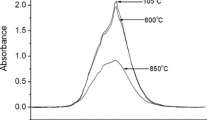Abstract
Talc specimens heated to 700–1450° C were examined with an analytical high-resolution transmission electron microscope. Neither the amphibole-like structure nor the MPP structure (M = mica, P = pyroxene-layer), proposed by Avgustinik and Vigdergauz (1948) and Sueno et al. (1980), was found. On the contrary, a disordered pyribole structure was observed. This pyribole showed a structure disordered in terms of chain widths, with single and double chains predominant. A local MPP structure with 4–6 repeated units of (21) sequence was generally observed in a disordered region. The electron diffraction data were consistent with maximum symmetry A2/m for the proto-MPP structure. A HRTEM study of the fine structures associated with the depolymerization of talc was the basis of a structural model proposed for the depolymerization of biopyriboles. In this model, a pair of (010) faults with a displacement of 1/2 (a+c) took an important role. The acceptor and donor regions model was also discussed.
Similar content being viewed by others
References
Akai J (1981) High resolution electron microscopic investigation on the genesis of the silicate with multiple chain structures — Polymerization and depolymerization processes of biopyriboles — (in Japanese with English abstract). J Cryst Soc Jpn 23:24–35
Akai J (1982a) Polymerization process of biopyribole in metasomatism at the Akatani ore deposit. Japan Contrib Mineral Petrol 80:117–131
Akai J (1982b) Direct observation of fine structures of minerals in metasomatism (in Japanese with English abstract). Earth Sci 36:69–76
Akai J, Tomita K, Yamaguchi Y (1985) High resolution electron microscopic observation of pyroxene lamellae in oxyhornblende. Earth Sci 38:334–345
Akizuki M (1967) Transformation of talc, chlorite and muscovite by an electron bombardment (in Japanese with English abstract). J Jpn Assoc Mineral Petrol Economic Geol 58:161–169
Avgustinik AI, Vigdergauz VS (1948) Properties of talc during heating. Ogneupory (Engl Transi) 13:218–227
Ball MC, Taylor HFW (1963) The dehydration of chrysotile in air and under hydrothermal conditions. Mineral Mag 33:467–482
Bateman G (1948) On the power function of the longest run as a test for randomness in a sequence of alterntives. Biometrika 35:97–112
Brindley GW, Bish DL, Wan HM (1977) The nature of kerotite, its relation to talc and stevensite. Mineral Mag 41:443–452
Chisholm JE (1973) Planar defects in fibrous amphiboles. J Mater Sci 8:475–483
Daw JD, Nicholson PS, Embury JD (1972) Inhomogeneous dehydroxylation of talc. J Am Ceram Soc 55:149–151
Gibbons JD (1985) Nonparametric statistical inference 2nd edn. Dekker, New York, Basel
Nakahira M, Kato T (1964) Thermal transformations of pyrophyllite and talc as revealed by X-ray and electron diffraction studies. Clays Clay Miner 12:21–27
Nakajima Y, Ribbe PH (1981) Texture and structural interpretation of alteration of pyroxene to other biopyriboles. Contrib Mineral Petrol 78:230–239
Perdikatsis B, Burzlaff H (1981) Strukturverfeinerung am Talk Mg3(OH)2SiO10. Z Kristallogr 156:177–186
Seto K (1929) Chemical composition of talcs from Ogushi, Japan and Dashiqiao, China (in Japanese). J Jpn Assoc Mineral Petrol Economic Geol 1:234
Souza Santos H, Yada K (1988) Thermal transformation of talc as studied by electron-optical methods. Clays Clay Miner 36:289–297
Sueno S, Prewitt CT, Ohmasa M (1980) Topotactic decomposition of some silicates (in Japanese with English abstract). J Mineral Soc Jpn Spec Issue 2:339–363
Thompson JB Jr (1970) Geometrical possibilities for amphibole structures: model biopyriboles. Am Mineral 55:292–293
Thompson JB Jr (1978) Biopyriboles and polysomatic series. Am Mineral 63:239–249
Thompson JB Jr (1981) An introduction to the mineralogy and petrology of biopyriboles. In: Veblen DR (ed) Amphiboles and other hydrous pyriboles — mineralogy. Reviews in Mineralogy 9A. Mineralogical Society of America, pp 141–188
Veblen DR (1981) Non-classical pyriboles and polysomatic reactions in biopyriboles. In: Veblen DR (ed) Amphiboles and other hydrous pyriboles — mineralogy. Reviews in Mineralogy 9A. Mineralogical Society of America, pp 189–234
Veblen DR, Bish DL (1988) TEM and X-ray study of orthopyroxene megacrysts: Microstructure and crystal chemistry. Am Mineral 73:677–691
Veblen DR, Burnham CW (1978a) New biopyriboles from Chester, Vermont: I. Descriptive mineralogy. Am Mineral 63:1000–1009
Veblen DR, Burnham CW (1978b) New biopyriboles from Chester, Vermont: II. The crystal structures of jimthompsonite, clinojimthompsonite, and chesterite, and the amphibole-mica reaction. Am Mineral 63:1053–1073
Veblen DR, Buseck PR (1979) Chain-width order and disorder in biopyriboles. Am Mineral 65:687–700
Veblen DR, Buseck PR (1980) Microstructures and reaction mechanisms in biopyriboles. Am Mineral 65:599–623
Veblen DR, Buseck PR (1981) Hydrous pyriboles and sheet silicates in pyroxene and uralites: Intergrowth microstructures and reaction mechanisms. Am Mineral 66:1107–1134
Wadsley AD, Andersson S (1970) Crystallographic shear, and the niobium oxides and fluorides in the composition region MXx, 2.4<X<2.7. In: Dunitz JD, Ibers JA (eds) Perspectives in structural chemistry, vol. 3. Wiley, New York, pp 1–58
Warren BE (1930) The structure of tremolite H2Ca2Mg5(SiO3)8. Z Kristallogr 72:42–57
Author information
Authors and Affiliations
Rights and permissions
About this article
Cite this article
Konishi, H., Akai, J. Depolymerized pyribole structures derived from talc by heating. Phys Chem Minerals 17, 569–582 (1991). https://doi.org/10.1007/BF00203836
Received:
Issue Date:
DOI: https://doi.org/10.1007/BF00203836




